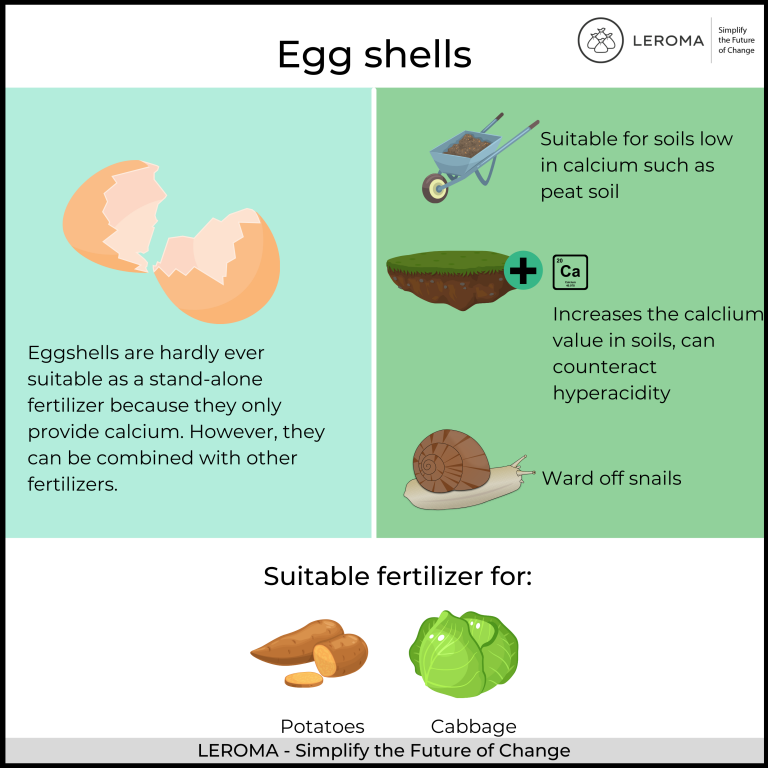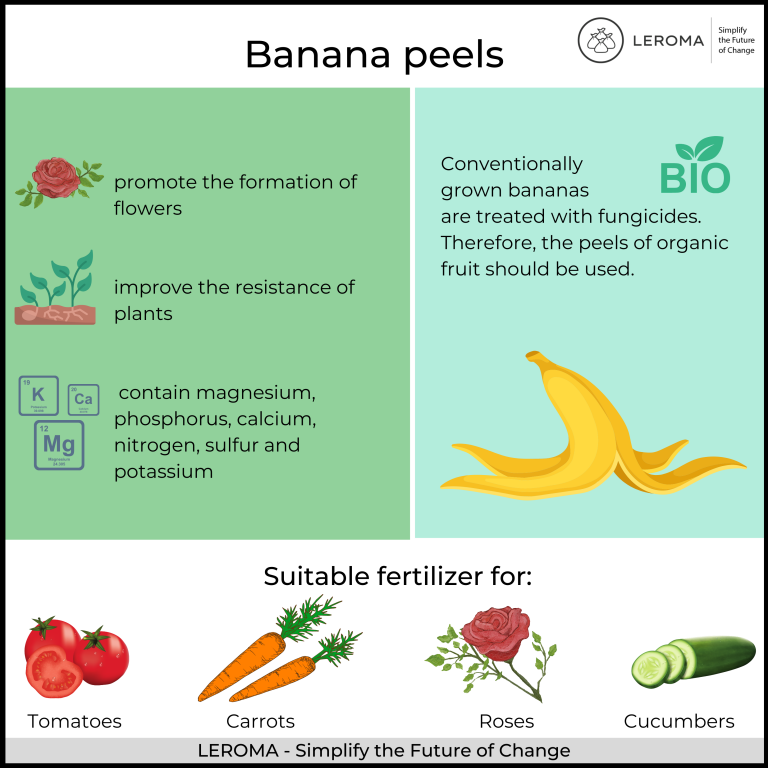Natural fertilizers through upcycling
In our magazine, we have already introduced you to various residual materials that arise during food processing and offer a mostly undiscovered variety of applications. We started with our article on the possible uses of coffee grounds at the beginning of February, followed by walnut shells, eggshells, fish scraps and others. In this way, we want to continuously draw attention to the waste of valuable raw materials that can be passed on in the sense of a circular economy. For various industries, the use of residual materials represents a cheap and sustainable alternative to conventional, sometimes artificial materials, and also reduces the CO2 emissions and costs that would be incurred if they were disposed of.
This week, we looked at residual materials, which can serve as a natural fertilizer, among other things, because the nutrients they contain enrich the soil and can be used by plants.
Coffee grounds
We have already reported that
coffee grounds can be used, among other things, as a natural fertilizer, but would like to elaborate on this possible application here.
Coffee grounds are a by-product of the production of soluble coffee, not only in private households, but especially in the industrial production of soluble coffee varieties and coffee-based beverages. Thus, for every kilogram of soluble coffee produced, there are about two kilograms of coffee grounds.
The enormous quantities of grounds can and should be collected because they are rich in nitrogen, potassium, phosphorus, tannic acid and antioxidants; nutrients that are valuable for plants and also components of conventional fertilizers. Nitrogen is a particularly important fertilizer element because plants need it to grow and many soils tend to be low in nitrogen. Phosphate stimulates flower formation, promotes fruit ripening and can prevent deficiency symptoms.
Potassium is important for cell structure and increases plant stability, improving resistance to cold and drought. The tannic acid it contains is the reason coffee grounds have a low pH and acidify the soil. Thus, the residue is especially good for acid-loving plants such as tomatoes, beans, cucumbers and blueberries. In addition, it can be widely distributed to protect against slugs, since it is toxic to many species, and it neutralizes the tracks that ants lay for orientation. It is important that the coffee grounds are dried before use, as they easily mold when wet, and not applied to fertilize seedlings, because they can not tolerate the caffeine. Coffee grounds can be added not only to the soil, but also to the compost. There it accelerates decomposition and provides food for earthworms.
Coffee consumption increased by 1.5 percent in 2020 compared to the previous year, from an average per capita consumption of 166 liters per year to 168 liters. Thus, the residual material is permanently available in large quantities and offers a natural alternative to mineral fertilizers.
Mineral fertilizers are produced with the help of chemical processes and are widely used because they act very quickly and can correct acute nutrient deficiencies of plants in a short time. The required ingredients are often obtained from sedimentary rocks, deposits that have a particular fossil abundance and contain many nutrient elements. The nutrients are present as salt in a solid compound that is hardly soluble and must be chemically processed so that they can dissolve in the soil and be absorbed by plants. Nitrogen is produced synthetically for mineral fertilizers, which requires a large amount of energy. In general, it does not make sense to work permanently with only mineral fertilizers, because over time organic substances are degraded and not renewed, i.e. soil fertility deteriorates. In addition, the acidity of the soil can change, which, among other things, can inhibit the nutrient uptake of plants and thus negatively affect growth. Furthermore, if applied incorrectly, it quickly happens that excess nutrients are washed out and contaminate the groundwater.

Eggshells
In addition to coffee grounds, eggshells are also a residual material that is available in enormous quantities and is used far too rarely. In our article about the possible applications of the shells, we have already mentioned that they can be used as fertilizer because of the calcium of which they are mainly composed. Calcium is an essential nutrient not only for humans and animals, which need the mineral for the stability of their bones, but also for plants. Calcium loosens the soil and promotes nutrient uptake and thus plant growth. Eggshells are hardly suitable as a stand-alone fertilizer, as they provide almost only calcium, but they can be combined with other fertilizers or used especially for calcium-poor soils such as peat soil or particularly calcium-loving plants such as potatoes or cabbage. Calcium also increases the pH value of soils and can thus counteract acidification, for example. To use eggshells as fertilizer, they should be crushed or even ground, because the smaller they are, the faster they decompose and develop their effect. At the same time, the crushed shells are a good defense against snails, which would injure themselves on the sharp-edged pieces and therefore stay away from them.
Precisely because the shells are more suitable as an additional fertilizer and are often combined with other means, it should be carefully observed which substances react with calcium, because, for example, in combination with phosphate, which is contained in many mineral fertilizers, form calcium phosphates that are difficult to dissolve, making the nutrients inaccessible to plants.
Eggshells are not suitable for compost, because they are not organic matter and decompose very slowly.
Fermentation residues
When biomass is fermented to produce biogas, solid or liquid residues remain, which are referred to as digestate, fermentation product or biogas slurry and can be used as fertilizer. In general, digestate is rich in nitrogen, ammonium, phosphorus, potassium, and sulfur, however, the nutrient composition of the residue is highly dependent on what the biomass is made of that is being fermented. Magnesium, calcium or other nutrients also remain in the digestate when they are added by the raw materials in the biomass. The nutrients they contain are very readily available to plants and do not require further processing. In addition, the digestate has a low viscosity and penetrates quickly into the soil, which is an advantage compared to slurry, for example; the urine and feces of farm animals, which is also used as fertilizer.
The digestates increase the microbial activity of the soil for about 9 weeks, which has a positive effect on soil fertility. They are also said to increase aggregate stability, meaning the soil can be worked more easily and soil erosion caused by water or wind is reduced. Any pollutant levels, such as heavy metals, are so low that they do not pose a risk in agricultural use.
Banana peels
Around 11.4 kilograms of bananas are consumed per capita in Germany each year. However, the popular fruit from the south has more to offer than the vitamin-rich flesh, because the peels, which are regularly discarded, are a natural fertilizer. They contain magnesium, phosphorus, calcium, nitrogen, sulfur as well as other trace elements and, above all, potassium. Since conventionally grown bananas are regularly treated with fungicides, organic fruit peels should be used for agricultural purposes. They can be used fresh or dried and incorporated into the soil near the roots. It is recommended to crush them so that the nutrients can be absorbed better and faster, for example, from roses, tomatoes, cucumbers or carrots. The shells promote flowering and improve the resistance of plants.
They can also be added to the compost, as they decompose very quickly. In addition to the residues shown in this article, many other vegetable wastes can be composted when they are no longer suitable for consumption to save them from the garbage can or landfill. Compost consists of decomposed organic material, promotes soil life and improves soil structure.

Residual materials contain numerous valuable nutrients that far too often go unused, even though they are a sustainable alternative to mineral fertilizers, for example. With this article, we at LEROMA would like to draw attention once again to the fact that by-products generated during food processing have incredible potential.
Let’s simplify the future of change!





